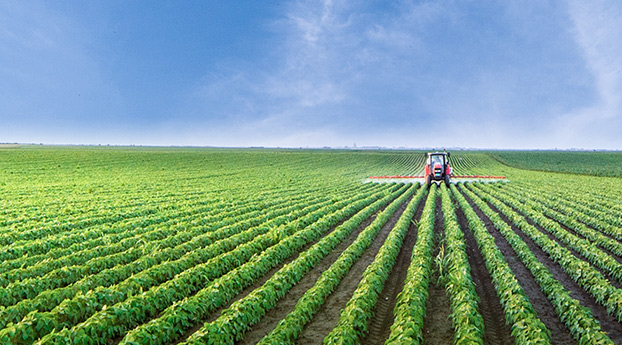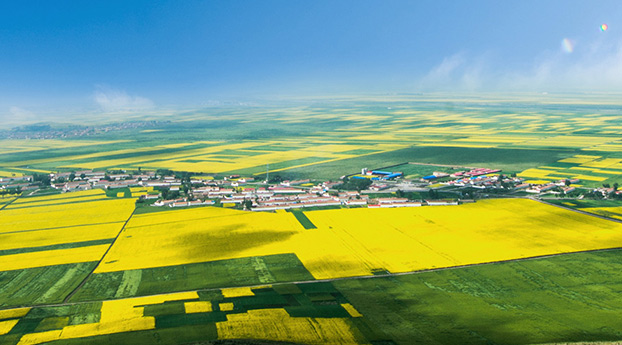Dynamic changes and migration characteristics of soil inorganic phosphorus in Three Gorges Reservoir area
Release time:2015-01-29 Views:82
【作者】 韩晓飞;
【导师】 谢德体; 高明;
【作者基本信息】 西南大学 , 土壤学, 2016, 博士
【摘要】 人口数量大,资源短缺和环境恶化是制约中国社会、经济发展和人们生活水平提高的三大障碍。当前,全世界范围内正面临着粮食增产与维护和改善农业生态环境质量的挑战,治理农业面源污染是其中的重要内容。党的“十八大”将生态文明建设与经济、政治、社会、文化建设摆在了同等重要位置,对治理农业面源污染高度重视,要求打好农业面源污染防治攻坚战。磷素是农业生产中最为重要的养分限制性因子,然而,由于其过量施用已经引起了严重的水体富营养化问题,大量研究已经表明,磷素是引发农业面源污染的主要元素之一,而且是关键性元素。所以建立兼顾作物高产和环境保护的土壤磷素推荐施肥体系及耕作措施对于农业生产和水环境保护具有重要意义。土壤磷对生态系统的作用机制是在土壤-水-大气-生物界面之间交换性迁移中形成的,土壤磷素农业面源污染具有明显的系统特征和地域特征。紫色土主要分布在长江中上游,占三峡库区耕地面积的78.7\%,随着土地利用强度加大,水土流失日益严重,造成了土壤养分的流失和水体富营养化污染,加剧了生态环境恶化。因此,研究特定区域尺度内的土壤磷素流失强度、通量以及时空变异规律,配置科学技术,调整适地磷肥管理,发展有机生态农业,强化典型农作系统的磷素循环,探明磷素原位截留和生态拦截净化机理,达到进一步消减农田土壤磷素养分的输出之目的。综合减排是土壤磷农业面源污染机理与调控技术研究发展的新趋势,主要在土壤微生态方面弄清磷流失污染的过程,优化化学磷肥以及有机肥施用量和配施比例,综合降低磷污染物在土壤、水体等多界面上的发生量。本研究结合我国目前“一控两减三基本”的农业资源和环境对策,通过源头控制,中间阻控和末端消纳的技术手段,注重化肥减量优化以及有机无机肥配合施用,弄清了化肥和有机肥施用条件下紫色土农田土壤磷素流失源强及其径流和淋溶迁移特征,为全面认识三峡库区紫色土农田磷素流失和有效评价磷流失对水环境风险提供了科学依据。本文以我国三峡库区主要农田土壤紫色土为材料,采用田间长期定位试验与野外原位定点监测并结合室内实验分析的方法,通过22年水旱轮作长期定位试验从时间和空间尺度上研究了长期定位施肥和长期保护性耕作制度下紫色土无机磷变化特征,运用化学测试和系统的土-水-植并析的生态学观点,研究了紫色土旱坡地土壤无机磷迁移特征及主控因素以及稻-油水旱轮作紫色土无机磷素动态变化及其迁移特征,最后建立土-水-植耦合的紫色土农田磷素迁移流失模型,为预测三峡库区紫色土农田土壤磷素流失量,制定合理的施肥和耕作措施提供了较为可靠的科学依据和理论基础。获得的主要研究结论如下:1.应用蒋柏藩-顾益初无机磷分级体系对22年长期定位施肥试验紫色土0~100cm土层各形态无机磷进行分级测定,研究了各形态无机磷在土壤剖面的分布及变化规律。结果表明,长期施用化学磷肥以及有机无机肥配施处理的土壤全磷、有效磷和各形态无机磷均较试验前有不同程度的增加,且以猪粪+npk(m+npk)处理土壤增加最多,其中有效磷含量增加了6倍;不施肥(ck)和单施氮肥(n)的处理土壤有效磷、全磷和各形态无机磷出现了下降,其中有效磷含量分别降低了51.1\%和53.5\%。除了fe-p和ca10-p含量下层高于上层外其余各形态无机磷都表现为耕层高于下层的特征。各处理ca2-p、al-p、ca8-p、o-p等无机磷的剖面分布较为相似,均呈20~60cm下降比较迅速,80~100cm变化不大或者稍微上升的趋势,而fe-p则表现为随土层深度增加呈上升趋势。相关分析表明各组分无机磷对紫色土有效磷的贡献为ca2-p(0.9569)>al-p(0.9265)>ca8-p(0.9100)>fe-p(0.8277)>ca10-p(0.7449)>o-p(0.7362)。长期有机无机肥配施可以显著增加磷素在土壤中的累积,并能减少土壤对磷素的固定,增强其在土壤中的移动,促进土壤磷素向有效态转化。2.以1990年建立的耕作制定位试验田紫色土为研究对象,分析了常规中稻-冬水田平作(cf)、中稻-冬水田垄作免耕1(rnt1)、中稻-小麦或油菜垄作免耕2(rnt2)和中稻-小麦或油菜水旱轮作(cr)等耕作方式对紫色土剖面不同形态无机磷分布演变特征的影响。结果表明:与试验前土壤相比,长期不同耕作处理的土壤上下层全磷、有效磷和各形态无机磷均有不同程度的增加,各处理土壤中不同形态无机磷含量大小顺序为rnt2>cf>cr>rnt1。除了fe-p含量下层土壤高于上部耕层外,ca2-p、ca8-p、al-p、ca10-p、o-p都表现为耕层高于下层的特征。不同耕作措施对紫色土剖面各形态无机磷含量影响显著,对各形态无机磷有效性影响效果为cr>rnt>cf。长期水旱轮作更有利于作物对磷的吸收。从各形态无机磷在不同剖面紫色土总无机磷中所占比重来看,ca10-p和o-p较大,钙磷整体所占比重最大。3.从不同施肥条件下紫色土旱坡地磷素年际流失特征可以看出,总磷(tp)和总可溶性磷(tdp)流失量有明显的差异。各处理tp和tdp变化范围比较大,分别为0.06~1.58kg·hm-2·a-1和0.009~0.268kg·hm-2·a-1。从2011~2014年不同施肥处理tp和tdp平均流失总量可以看出,tp流失量大小依次为倍量施磷肥(2p)>优化施肥(p)>优化施肥+猪粪有机肥(mp)>优化施肥+秸秆还田(sp)>优化施肥量磷减20\%+猪粪有机肥(mdp)>优化施肥量磷减20\%+秸秆还田(sdp)>不施磷肥(p0)。倍量施磷肥(2p)处理流失总磷量最高。优化施肥(p)处理分别是优化施肥量磷减20\%+秸秆还田(sdp)处理和优化施肥量磷减20\%+猪粪有机肥(mdp)处理的1.5~2倍左右。tdp流失量与tp流失量大小顺序稍有不同,各处理大小依次为倍量施磷肥(2p)>优化施肥+猪粪有机肥(mp)>优化施肥(p)>优化施肥量磷减20\%+猪粪有机肥(mdp)>优化施肥+秸秆还田(sp)>优化施肥量磷减20\%+秸秆还田(sdp)>不施磷肥(p0)。各施肥处理磷素流失量与降雨量做相关性分析得出,总磷累积流失量和累积降雨量呈y?aln(x)-b,a?0(r2=0.8306~0.9473)对数关系相关,总可溶性磷累积流失量和累积降雨量呈y?ax?b,a?0(r2=0.9302~0.9803)线性关系相关(其中p0处理为对数关系相关)。同时采用野外径流小区对紫色土旱坡地2014年雨季(5~8月)3次典型降雨产流进行定点监测,研究了p、2p、mp、sp、mdp、sdp、p0等不同施肥方案对紫色土旱坡地地表径流和壤中流磷素流失的影响。结果表明:紫色土旱坡地地表径流和壤中流受降雨强度影响,雨季次降雨中雨到暴雨平均径流量为10.68~52.32mm,泥沙量为13.58~40.20kg·km-2,壤中流占总径流的53\%以上,壤中流是雨季径流主要输出途径。而次降雨地表径流总磷(tp)平均含量和流失负荷都远高于壤中流,地表径流磷素流失是紫色土旱坡地雨季磷素流失主要方式。发现减磷配施有机肥对紫色土旱坡地坡面径流中磷素流失有显著消减效应,sdp、mdp分别比p处理的总磷含量降低57\%和48\%,配施秸秆效果好于配施猪粪有机肥。次降雨磷素平均流失负荷为0.01~0.47kg·hm-2,磷素平均流失负荷表现为2p>p>mp>sp>mdp>sdp>p0。减磷配施猪粪和秸秆有机肥对土壤磷素地表径流损失具有显著消减效应,但增加壤中流磷素淋失风险。因此要控制磷素流失首先要控制水土侵蚀,在平衡配施有机肥的同时要注意采取增厚土层,提升土壤有机质等综合治理措施。不同施肥处理对冬小麦-夏玉米生长发育和磷肥利用率的影响研究表明,冬小麦季和夏玉米季都以倍量施磷肥(2p)处理作物磷吸收量为最高,但是磷素表观利用率却不高。小麦季优化施肥量磷减20\%+秸秆还田(sdp)和优化施肥量磷减20\%+猪粪有机肥(mdp)处理分别比常规优化施肥(p)处理磷肥表观利用率高5.9\%和4.2\%。玉米季有机无机肥配施处理磷肥表观利用率也显著高于单施化肥处理(p<0.05)。尽管倍量施磷肥(2p)处理可以增加作物对磷素的吸收量,但是经济效益和利用率却大大降低,会导致肥料资源的浪费和环境的污染。有机无机肥配施可以显著提高作物对磷肥的吸收利用。紫色土旱坡地冬小麦和夏玉米适当减磷配施有机肥可以在不减产的前提下提高磷肥的利用率并能降低对水环境污染。4.优化及减磷配施有机肥对水稻、油菜生长发育和磷肥利用率的影响研究结果表明,在常规作物施肥基础上适当减少化学磷肥施用量,并配合施用有机肥,对作物产量并没有产生显著的减产效应,而且能在一定程度上减少农田磷素损失提高磷素利用率。水稻对磷肥的利用率总体表现为:优化施肥量磷减20\%+猪粪有机肥(mdp)>优化施肥量磷减20\%+秸秆还田(sdp)>优化施肥+猪粪有机肥(mp)>优化施肥+秸秆还田(sp)≈优化施肥(p),各处理磷肥利用率在20\%~25\%之间。油菜对磷肥的利用率总体表现为:优化施肥量磷减20\%+秸秆还田(sdp)>优化施肥量磷减20\%+猪粪有机肥(mdp)>优化施肥+猪粪有机肥(mp)>优化施肥+秸秆还田(sp)>优化施肥(p),各处理磷肥利用率在17\%~29\%之间。油菜不同生育期土壤磷素动态变化研究结果表明,有机无机肥配施可以显著提高土壤有效磷含量。蕾薹期土壤有效磷较苗期有一个明显的降低,但在油菜开花期和收获后期,土壤有效磷有一个明显的上升,油菜生长花期以后是土壤有效磷淋失的主要时期。不同施肥处理对稻田田面水tp含量动态变化研究表明,在水稻生长前一个月内,田面水总磷含量随着施磷水平的增加而增加,优化施肥(p)比不施磷肥(p0)处理总磷含量高4倍左右。各处理磷含量大小表现为p>mp>sp>mdp>sdp>p0。一个月后不同施肥处理田面水总磷含量基本一致,80天后各处理总磷含量接近不施磷处理。磷肥施用后的7~10天内是控制稻田磷素流失的关键时期,在此时期内任何降雨径流或者人为扰动以及农田排水都可能使得大量的磷素流失进入水环境之中,从而增加对水体污染的风险。为探索长江流域稻油轮作系统水稻季减少农田磷素流失的最佳施肥模式和有效耕作措施,降低其对长江水质的威胁。采用渗漏池长期田间原位定点试验并结合室内实验分析,研究了化肥配施猪粪有机肥和水稻秸秆还田对土壤磷素淋溶迁移的影响。结果表明在水稻生长期内土壤淋溶水中磷素浓度随时间延长呈逐渐下降的趋势,前期波动幅度大且下降迅速,到55天之后逐步稳定达到平衡。总可溶性磷(tdp)是渗漏水磷素的主要形态。土壤淋溶水中总磷(tp)和总可溶性磷(tdp)含量均表现为mp>sp>p>mdp>sdp>p0。土壤总磷(tp)淋失负荷在0.295~0.493kg·hm-2之间。化学磷肥减量有利于降低土壤淋溶水中磷素淋失量。p0处理比p处理总磷淋失量降低39\%。mdp和sdp处理比mp和sp处理三层总磷淋失量分别降低21.7\%和19.6\%。施用有机肥提高了淋溶水中的磷素含量,促进了土壤中磷素的淋失,同时显著提高了土壤中有效磷的含量,猪粪有机肥的促进作用比水稻秸秆大。通过本试验研究各施肥处理对作物生长、磷肥利用率和对土壤磷素有效性的贡献及其磷素淋失对水环境风险大小可以看出化学磷肥减量和秸秆配施是应对农业面源污染“控源节流”的较好措施。在综合考虑农业生产省本增效和控制农田面源污染的情况下,可以采取减量化肥配施有机肥的施肥模式。5.土-水-植耦合的紫色土农田磷素迁移流失模型可以较好的模拟预测水田田面水可反应性无机磷(MRP)含量变化特征和三峡库区紫色土旱坡地磷素迁移流失特征。其中稻田磷素流失模型中固定速率常数最敏感,对结果影响作用最大。施肥初期排水会导致磷素随排水损失增加,因此,合理排灌对控制紫色土稻田磷素流失有其积极意义。利用紫色土22年长期定位施肥试验和长期不同耕作制试验监测基地以及原状土壤渗漏池,从时间和空间尺度上,并兼顾水田、旱地土壤,系统研究了三峡库区紫色土中磷素的迁移转化特征,获得了大量的基础性监测数据和研究成果,为三峡库区紫色土农田土壤磷肥的优化管理以及施行合理的施肥和耕作制度提供了理论依据。全面系统的研究了不同磷素水平以及不同种类有机肥对三峡库区紫色土农田土壤无机磷迁移流失的影响,得出优化施肥量磷减20\%配施秸秆有机肥可以作为一种从源头控制紫色土农田土壤磷素流失的较好措施加以推广。
【Abstract】 Population surplus, shortage of resources and deterioration of environment are the three obstacles which restrict the development of China’s society, economy and people’s living standard. Currently, the world is facing the challenges of maintaining food production growth and the improvement of agricultural ecological environmental quality. The Eighteenth National Congress of the CPC has put the ecological civilization construction and the economic, political, social and cultural construction in the equally important position, the agricultural non-point source pollution governance has attracted great importance to good agricultural non-point source pollution control. Phosphorus is one of the agricultural production in the most important nutrient limiting factor, however, the excessive application has caused serious eutrophication problems. A large number of studies have also shown that, phosphorus, which is a key element, is one of the main elements to result in agricultural non-point source pollution. So the establishment of both soil phosphorus with high crop yield and environmental protection in the appropriate phosphorus fertilization recommendation system has important significance for agricultural production and water environmental protection.The soil phosphating, exchange and transfer between typical soil-water-atmosphere interfaces, and agricultural non-point source pollution has an obvious geographical and systematic characteristics. Purple soil is mainly distributed in the upper reaches of Yangtze River, consists of 78.7\% of the cultivated area in the Three Gorges Reservoir area. With the increase of land use intensity, soil erosion is becoming increasingly serious, resulting in the loss of soil nutrients and eutrophication pollution, exacerbated the deterioration of the ecological environment. Therefore, the intensity of flux and temporal variation of soil phosphorus decreased in specific region. By applying science and technology,improving the fertilizer management as well as the organic agriculture and strengthening the typical circulation, in situ proven purification ecological and interception of phosphorus, the output of phosphorus in soil nutrient has been further reduced. The Comprehensive emission reduction is a new trend of soil phosphorus in agricultural non-point source pollution mechanism and control technology research and development, mainly in the process of soil micro ecology to loss of phosphorus pollution. It can also optimize chemical fertilizer,organic fertilizer and their ratio and reduce the amount of phosphorus pollutants that are released to soil and water.This study combined with the current ―control and reduction‖ strategy, we pay attention to the optimization of chemical fertilizer reduction and organic and inorganic fertilizer combined application and find out the condition of chemical fertilizer and organic fertilizer in purple soil, soil phosphorus element loss source intensity and runoff and leaching characteristics for a comprehensive understanding of purple soil agricultural phosphorus element loss and effective evaluation of phosphorus loss. In this paper, we took the main purple soil of our farmland in Three Gorges area as materials, by the 22 years long-term field experiment and field observation method with laboratory analyse, to get the temporal and spatial scales of the long-term variation characteristics of soil profiles of inorganic phosphorus in purple soil under the application of inorganic fertilizer, the evolution of phosphorus and long-term conservation tillage system. The winter wheat and summer maize rotation system was used to study the migration and transformation characteristics and controlling factors. Meanwhile, the rice-rape cropping system in puple soil was also used to study the phosphorus characteristics in both soil and water systems. In doing so, we aimed to establish the soil-water-planting coupling of purple soil agricultural phosphorus element migration loss model, for the prediction of soil phosphorus loss amounts in the Three Gorges Reservoir to develop reasonable fertilization and tillage measure. The main results were as follows:1.Taking the Jiang Bofan-Gu Yichu Inorganic phosphorus Grading System to conduct grading measurement on the morphology of inorganic phosphorus of the 0-100 cm purple soil layer in the 22-year long-term fertilization experiment. The results showed that, compared to the status before the experiment, the total phosphorus, available phosphorus and various forms of inorganic phosphorus had all increased to a certain degree in the soils with long-term application of chemical phosphate and the combination of organic fertilizer and chemical fertilize. Among these fertilizations, the pig manure+NPK(M+NPK) had increased the content of available phosphorus by six times; while the available phosphorus, total phosphorus, and various forms of inorganic phosphorus had reduced in the soil without fertilization(CK) and the sole nitrogenous fertilizer(N). In particular, the contents of available phosphorus had reduced by 51.1\% and 53.5\% under CK and N, respectively. In addition, the contents of Fe-P and Ca10-P in the lower layer were higher than those in the upper layer, all other forms of inorganic phosphorus were higher in the arable layers than in the lower layers. The distributions of inorganic phosphorus like Ca2-P, Al-P, Ca8-P, and O-P in the soil profile were all similar to each other, and all had reduced quickly at 20-60 cm, but were similar or had a slightly increase trend at 80-100 cm. In addition, the phenomenon of the content of Fe-P in lower layer higher than that in the arable layer. It had been shown by relevant analysis that the contribution of various groups of inorganic phosphorus to purple soil was Ca2-P(0.9569) > Al-P(0.9265) > Ca8-P(0.9100) >Fe-P(0.8277) >Ca10-P(0.7449) >O-P(0.7362). Long-term of combined application of organic and inorganic fertilizers could significantly increase the accumulation of phosphorus in soil, suppress the decreasing of P fixation, enhance P mobility and P use efficiency.2. In this study the effects of tillage methods(rice-winter paddy field conventional farming, CF; rice-winter paddy field combing ridge with no-tillage, RNT1; rice-wheat or rape combing ridge with no-tillage, RNT2; rice-wheat or rape conventional paddy-upland rotation tillage, CR) on purple soil profile of different forms of inorganic phosphorus distribution were investigated in a long-term experimental site established in 1990, Chongqing City, China. The results had shown that, compared to the status before the experiment, the total phosphorus, available phosphorus and various morphologies of inorganic phosphorus had all increased to a certain degree in the soils with long-term different tillage treatment, and the different forms of inorganic phosphorus content in soil size order is RNT2>CF>CR>RNT1. In addition to that the contents of Fe-P in the lower layer were higher than those in the upper layer, all other various morphologies of inorganic phosphorus had all characterized as that the arable layers were higher than the lower layers. The effects of farming practices on availability of various phosphorus farms were significant. They were in the order of CR>RNT>CF. Long-term of conventional paddy-upland rotation tillage was more advantageous to crops on the absorption of phosphorus. From the different inorganic phosphorus in different purple soil profiles in the proportion of total inorganic phosphorus, Ca10-P and O-P were higher, so calcium and phosphate took the largest proportion of all.3. In different fertilization conditions, the characteristics of the annual runoff of the soil under drought sloping field could be seen that the loss of total phosphorus(TP) and total soluble phosphorus(TDP) were significantly different under different fertilization treatments. Each treatment TP and TDP change range was large, 0.06~1.58 kg·hm-2·a-1 and 0.009~0.268 kg·hm-2·a-1, respectively. From 2011-2014 different fertilization treatments of TP and TDP average total loss could be seen, TP loss size followed by times the amount of applied fertilizer(2P) >optimum fertilization(P) >optimization fertilization + pig manure organic fertilizer(MP) >optimization fertilizer + straw(SP) >optimum amount of fertilizer phosphorus minus 20\% pig manure organic fertilizer(MDP) >optimization of fertilizer phosphorus reduced 20\% straw(SDP) >No application of phosphate fertilizer(P0). Optimization of fertilization(P) were about 1.5 to 2 times the optimum amount of fertilizer phosphorus reduction + straw(SDP) processing and optimization of fertilizer phosphorus minus 20\% pig manure as an organic fertilizer(MDP).TDP loss of TP loss and the quantity of the order of magnitude was slightly different, the size followed by times the amount of applied fertilizer(2P) >optimization fertilization + pig manure organic fertilizer(MP) >optimization fertilization(P) >optimum amount of fertilizer phosphorus minus 20\% pig manure organic fertilizer(MDP) >optimization(SP) fertilizer + straw >optimum amount of fertilizer phosphorus reduced 20\% straw(SDP) >Application of phosphate fertilizer(P0). The fertilizing phosphorus element loss and rainfall amount correlation analysis showed that, the total phosphorus accumulation loss and rainfall accumulation were y(28)a Ln(x)-b, a(29)0(R2=0.8306~0.9473) logarithmic relationship related, the total soluble phosphorus accumulation loss and rainfall accumulation were y(28)ax(10)b, a(29)0(R2=0.9302~0.9803)(the P0 is a logarithmic relationship relation). In order to better understand the effect of reduced phosphorus fertilizer and combining organic fertilizers on phosphorus loss of purple soil sloping field, three rainfall-runoff events were monitored by using field runoff observation method in the purple soil sloping field in 2014. There were six treatments in this research, including optimized fertilization(P), optimized fertilization +pig manure application(MP), optimized fertilization +straw return(SP), optimized fertilization which was reduced by 20\% +pig manure application(MDP), optimized fertilization which was reduced by 20\% + straw return(SDP), without phosphate(P0).The results indicated that the interflow was the main pathway of runoff for purple soil sloping field. The average contents of total phosphorus(TP) and the phosphorus loss load of overland flow were all much higher than the interflow. The overland flow was the main pathway of the phosphorus loss load for purple soil sloping field. Reduced phosphorus fertilizer and combining organic fertilizers had a significant reduction effect on phosphorus loss of purple soil sloping field. Compared with the treatment P, the average contents of total phosphorus on SDP was reduced by 57\% and on MDP was reduced by 48\% in the storm rainfall. Combining straw was better than pig manure. The average contents of the phosphorus loss load of typical rainfall were changed from 0.01 to 0.47 kg·hm-2. In different fertilization treatments, the average contents of the phosphorus loss load listed as follow: P>MP>SP>MDP>SDP>P0. Reduced phosphorus fertilizer and combining organic fertilizers had a significant reduction effect on phosphorus loss of overland flow, but increased soil phosphorus leaching for purple soil sloping field. Therefore, to control the phosphorus loss first to control soil erosion, fertilizer and organic fertilizer on the balance of the thick soil layer should be taken to enhance the comprehensive governance, soil organic matter and other measures. The influence on different fertilization treatments on winter wheat-summer maize growth and development showed that, the winter wheat season and summer maize season of all double the amount of phosphorus fertilizer(2P) were the highest, but phosphorus element on utilization rate was not high. Winter wheat optimal phosphorus fertilizer + straw(SDP) and optimum amount of fertilizer phosphorus reduction 20\%+pig manure organic fertilizer(MDP), the utilization rate of which respectively was 4.2\% and 5.9\% higher compared with the conventional optimal fertilizer(P) treatment of phosphate fertilizer. The apparent utilization rate of fertilizer application in maize season was also significantly higher than that of single fertilizer application(P<0.05). While the amount of phosphorus absorbed by the crop could be increased by the amount of(2P), the economic benefit and utilization rate was greatly reduced, which led to the waste of fertilizer resources and environmental pollution. The application of organic and inorganic fertilizer could significantly increase the absorption and utilization of phosphorus fertilizer in crops. The appropriate reduction of phosphorus and organic fertilizer could improve the rate of phosphorus fertilizer in the winter wheat and summer maize under the condition of no reduction of yield in purple soil.4. The effect of the results on optimization and reducing phosphorus with organic fertilizer on rice, growth development and phosphate fertilizer use rates showed that application, in conventional crop fertilization based on reducing the chemical fertilizer application amount, and combined application of organic fertilizer, on crop yield did not show significant reduction, and in some extent it could reduce agricultural phosphorus loss to improve phosphorus utilization. The utilization of phosphate fertilizer in rice rate overall showed that: optimization of fertilizer phosphorus minus 20\% pig manure organic fertilizer(MDP)>optimization of fertilizer phosphorus reduction + straw(SDP)>optimization fertilizer and hog manure organic fertilizer(MP)>optimize fertilizer + straw(SP)≈optimal fertilizer(P), the treatment of phosphate fertilizer and using rate between 20\% to 25\%. Rape of phosphate fertilizer utilization rate of overall performance: the optimizing fertilization and phosphorus reduction 20\%+straw(SDP)>optimum amount of fertilizer phosphorus reduced 20\%+pig manure organic fertilizer(MDP)>optimize fertilizer +hog manure organic fertilizer(MP)>optimization fertilizer + straw(SP)>optimal fertilizer(P), the treatment of phosphate fertilizer using rate were between 17\%~29\%. Different growth periods of oilseed rape in the soil phosphorus element dynamic results showed that bud stage soil available phosphorus seedling significantly reduced, but in rape flowering stage and harvesting stage, soil available phosphorus had an obvious rise, it was the main period of soil available phosphorus leaching after the rape growth period. Different fertilization treatments on paddy field surface water TP content dynamic change research showed that, in the rice growth within a month, field surface water total phosphorus content increased with the increase of the levels of phosphorus fertilizer, optimized fertilization(P) than no P fertilizer(P0) treatment and phosphorus content was about 4 times higher. The phosphorus content of the size performance for optimal fertilization(P) >optimization fertilization + pig manure organic fertilizer(MP) >optimization fertilizer + straw(SP) >optimum amount of fertilizer phosphorus minus 20\%+ pig manure organic fertilizer(MDP) >optimization of fertilizer phosphorus reduced 20\%+ straw(SDP) >Application of phosphate fertilizer(P0) after a month of different fertilization treatment field surface water total phosphorus content was basically the same, 80 days after the treatment of total phosphorus content close to no phosphorus treatments. The critical period of field control of phosphorus loss was after P put into the field in 7-10 days, during the period of any rainfall runoff or human disturbance and farmland drainage might make a lot of phosphorus loss in water environment, which could increase the risk of water pollution. In order to explore the effective tillage for reducing phosphorus leaching and improving river water quality,field experiments were conducted to study the effect of combined application of organic and inorganic fertilizers on phosphorus leaching in purple paddy soil of conventional paddy-upland rotation tillage. The results showed that the phosphorus seepage decreased over time, but the amount leached was high and variable at the earlier stages, gradually stable equilibrium after 55 days. The TDP was the dominant one in the P leaching water of the purple paddy soil. The soluble phosphorus and total phosphorus content in soil leachate listed as follow: optimized fertilization +pig manure application(MP)>optimized fertilization +straw return(SP)> optimized fertilization>optimized fertilization which was P reduced by 20\% +pig manure application(MDP)>optimized fertilization which was P reduced by 20\% + straw return(SDP)>without phosphate(P0). The change of TP loss load was between 0.295 and 0.493 kg·hm-2. Organic fertilizer promoted the phosphorus leaching, and the pig manure promoting effect was bigger than the rice straw. From the experiment research we ccould see different fertilization treatments on crop growth, phosphate fertilizer use rate and on soil phosphorus element effective and phosphorus element leaching risk to water environment, we could also draw the conclusion that chemical fertilizer reduction and straw with fertilizer were dealt with the agricultural non-point source pollution measures to ―control the sources and the runoff loss ". To improve the agricultural production and control the non-point source pollution, we could reduce the chemical fertilizers and then combine organic and inorganic fertilizers application.5. The water- soil- planting fields in purple soil dynamic loss model could be better to quantify the simulation and prediction of reactive phosphorus(MRP) content variation and characteristics of phosphorus transport and loss in purple soil sloping land in the Three Gorges reservoir area in surface water. Fixed rate constants was the most sensitive, and had maximum effect to the results. Drainage in the early stages of fertilization could lead to phosphorus with drainage losses increase. Therefore, a reasonable irrigation in paddy field had its positive significance to control phosphorus element loss.From 22 years long-term fertilization experiment and long-term farming system of purple soil in the test site and undisturbed soil seepage pool, with the time and space scales, taking into account the paddy field, dry land soil, we systematically studied the phosphorus migration transformation characteristics in purple soil in the Three Gorges area, and received a large number of basic monitoring data and research results, which could provide theoretical basis for purple soil cropland phosphorus optimized management and implementation of reasonable fertilization and tillage system. And to study the effects of different phosphorus levels and different kinds of organic fertilizer on phosphorus migration in purple soil, it was a good measure if the optimum amount of fertilizer phosphorus could be reduced by 20\% with the application of straw manure to control the soil phosphorus element loss in purple soil.
【关键词】 三峡库区; 紫色土; 无机磷; 旱坡地和水田; 径流和淋溶; 减磷配施有机肥;
【Key words】 Three Gorges reservoir area; Purple soil; Inorganic Phosphorus; Dry sloping fields and paddy fields; Runoff loss and leaching; Reduced phosphorus fertilizer combining organic fertilizers;

















